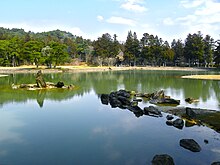
Hiraizumi (平泉, ) is a small town in Iwate, in the northeastern Tohoku region of Japan.
Understand
- 夏草や 兵どもが 夢の跡
- natsugusa ya tsuwamono-domo ga yume no ato
- Summer grass — all that remains of warrior dreams
- -- Matsuo Bashō
During the reign of the Fujiwaras (866-1184), Hiraizumi was said to rival Kyoto in grandeur and sophistication, but now all that remains are the temples of Chusonji and Motsuji, both of which are mostly in ruins at that. Famed haiku poet Matsuo Basho penned the famous haiku quoted above, with the end result that now Basho is quite possibly more idolized in Hiraizumi than anywhere else, and you can't throw a rock in Hiraizumi without hitting a Basho statue, a Basho monument, an inscribed copy of a Basho haiku or at the very least a coffee shop waving its "As mentioned in Narrow Road to the Deep North!" banners.
Get in
By train
Hiraizumi is on the JR Tohoku Main Line, connecting to Morioka in the north and Sendai to the south.
The nearest Shinkansen stop, Ichinoseki, is only 10 minutes away (¥170). Trains from Tokyo reach Ichinoseki in about 2 1/2 hours (¥12,470 for the one-way trip to Hiraizumi; no charge with the Japan Rail Pass).
Get around
Local buses connect JR Hiraizumi station to points of interest, although you can also reach them on foot. Bicycle hire is available just to the right of the station, it is ¥1,000 for the whole day (lesser periods are available) it allows you to get around quickly and enjoyably.
See

In 2011, six of the city's attractions were made World Heritage Sites under the name "Hiraizumi - Temples, Gardens, and Archaeological Sites Representing Pure Land Buddhism". Those sites are: Chuson-ji, Motsu-ji, Kanjizaio-in Ato, Muryoko-in Ato, Yanaginogosho Iseki, and Mount Kinkeisan.
- Chūson-ji Temple (中尊寺) (5 minutes by bus or 20 on foot from the station.). Hiraizumi's largest and most famous temple, renowned particularly for its Golden Hall (金色堂 Konjikidō) — which, unlike Kyoto's Golden Pavilion, is housed inside a large glass case. True to the name, the shrine inside is elaborately decorated with golden lacquer and mother-of-pearl, with three Buddha images. ¥800.
- Mōtsu-ji Temple (毛越寺) (10 minutes on foot from the station.). The second of Hiraizumi's two large temples, known for its Heian-era Pure Land Garden (浄土園 Jōdo-en) dating to 800 AD. The garden seems downright un-Japanese in its liberal use of wide, grassy spaces — but most of the open spaces have scattered rocks and are marked with small posts in the middle, indicating the locations of destroyed temple buildings. ¥500.
- Takkoku no Iwaya Bishamon-do (About 30 minutes bike ride out of town.). A nice cave temple. It is the 5th incarnation of the temple since it was established in 801. It is dedicated to Bishamon the god of war, but was called Iwaya Bishamondo -- a place to pray for peace. Also at this site is the Ganmen Daibutsu a giant stone carving of Budda, but only the head remains after an earthquake destroyed the body. The ride to the temple is enjoyable in itself with nice Japanese countryside all the way. Ironically, although it is often considered to be the most interesting site for tourists, it is one of the only local attractions that is not a World Heritage Site. ¥300.
- Kanjizaio-in Ato. Built by Fujiwara Motohira's wife, it was originally a large garden. A fire destroyed it in the 16th century but many of the structures were rebuilt. Today, it's more of a park, although there are still some preserved elements that remind you it was once a garden. Free.
- Muryoko-in Ato. This was formerly a temple, but all that remains today is the temple's pond.
- Yanaginogosho Iseki. This is the site of the former palace. Although no structures remain, the pond and foundations still give visitors an idea of how grand the palace once was. Excavations are still being done.
- Yanaginogosho Museum. Yanaginogosho Iseki is often closed to the public, so the museum provides a way for visitors to learn about Hiraizumi's history and the former palace.
- Kinkeisan. Buddhist sutras were once buried on this mountain.
Do
Buy
Eat
There are a number of small teahouses and souvenir stands in the grounds of Chūsonji.
- Eira Sushi (Walk west from Hiraizumi station to the second set of lights. Turn right and proceed on the east side of the road until you pass over a bridge. Eira Sushi is the second restaurant on your right.). Eira Sushi is the type of place you might just walk out of if you'd wandered in. There are several disconnected video game tables from the 80s, and the owner is an old woman who moves very slowly and at first glance appears to be not particularly interested in having guests, at least at lunch time.
There is no menu, just a bunch of sets listed on the wall. Three nigiri (sushi roll) sets, and two chirashi sets (sashimi on sushi rice). The cheapest set is 900 Yen, and the most expensive is 1700 Yen.
The owner makes the sushi herself, which is unusual (usually sushi chefs are men).
WARNING: Don't eat here if you're in a hurry. The owner is very, very slow at making the sushi. It's worth the wait, especially given the price, but if you have a bus or train to catch, be warned that it can take a long time. moderate.
Drink
Sleep
- Regrettably, Motsuji's well-known temple-run youth hostel was closed in 2007.
Go next
| Routes through Hiraizumi |
| Morioka ← Hanamaki Template:Lfarrow Kitakami Template:Lfarrow Mizusawa ← | N |
→ Ichinoseki → Sendai |
| Morioka ← Hanamaki Template:Lfarrow Kitakami Template:Lfarrow Mizusawa ← | N |
→ Ichinoseki → Sendai |
